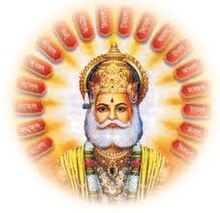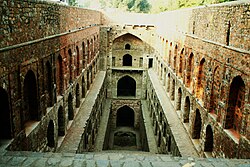 Maharaja Agrasen, the legendary king who was the forefather of Agrawals | |
| Regions with significant populations | |
|---|---|
| India, Pakistan, and Bangladesh | |
| Languages | |
| Punjabi, Haryanvi, Hindi, Rajasthani | |
| Religion | |
| Majority: Vaishnava Hinduism, Jainism, Sikhism Minority: Islam, Christianity[1][2] |
Agrawal (anglicisation: Agarwal, Agerwal, Agrawala, Agarwala, Agarwalla, Aggarwal, Agarawal or Agarawala) is a Bania caste.[3] The Banias of northern India are a cluster of several communities, of which the Agarwal Banias, Maheshwari Banias, Oswal Banias, Khatri Banias and Porwal Banias are a part.[4]
They are found throughout northern India, mainly in the states of Rajasthan, Haryana, Punjab, Jammu and Kashmir, Chandigarh, Himachal Pradesh, Uttarakhand, Delhi, Chhattisgarh, Gujarat, Maharashtra and Uttar Pradesh. They are also found in the Pakistani provinces of Punjab and Sindh, though at the time of the partition of India, most of them migrated across the newly created border to independent India.[5][6][7] Most Agrawals follow Vaishnava Hinduism or Jainism, while a minority adhere to Islam or Christianity.[1][8][2]
The Agrawal believe the ancestor of the community to be Maharaja Agrasen, a Kshatriya king of Agroha Kingdom.[9] Maharaja Agrasen himself adopted the Vaishya tradition of Hinduism.[9] The Agrawal are also known for the entrepreneurship and business acumen.[9] In modern-day tech and ecommerce companies, they continue to dominate. It was reported in 2013, that for every 100 in funding for e-commerce companies in India, 40 went to firms founded by Agrawals.[10]

- ^ a b Harrison, Selig S. (8 December 2015). India: The Most Dangerous Decades. Princeton University Press. p. 115. ISBN 978-1-4008-7780-5.
Some subsects of the Oswals and Agarwals were converted to Jainism in the 16th century.
- ^ a b Sikand, Yoginder; Katju, Manjari (20 August 1994). "Mass Conversions to Hinduism among Indian Muslims". Economic and Political Weekly. 29 (34): 2214–2219.
- ^ Patel, Aakar (6 February 2015). "A history of the Agarwals". mint. Retrieved 5 April 2024.
- ^ "A history of the Agarwal's". 6 February 2015.
- ^ Gupta, Babu Lal (1987). Trade and Commerce in Rajasthan During the 18th Century. Jaipur Publishing House. p. 88.
- ^ Das, Sibir Ranjan (2012). Resilience and Identity in Urban India: Anthropology of Barmer and Tehri. Anthropological Survey of India. p. 107. ISBN 978-81-922974-9-1.
- ^ Gulzar Ahmed Chaudhry (4 June 2014). "Nagar Mahal – from Agarwals to Sukheras". Dawn. Pakistan.
- ^ Goh, Robbie B. H. (8 February 2018). Protestant Christianity in the Indian Diaspora: Abjected Identities, Evangelical Relations, and Pentecostal Visions. SUNY Press. ISBN 978-1-4384-6944-7.
Agarwal recounts how the news of his own conversion was greeted by his grandmother in Punjab...
- ^ a b c Jodhka, Surinder S. (2023). The Oxford Handbook of Caste. Oxford University Press. p. 393. ISBN 978-0-19-889671-5.
- ^ Julka, Harsimran; Radhika P. Nair (12 February 2013). "Why young Aggarwals dominate India's e-commerce start-ups". The Economic Times. Delhi.
- ^ Down to Earth: Science and Environment Fortnightly, Volume 16, Issues 16-24. Society for Environmental Communications. 2008. p. 71.
Resembling Tughlak period architectures, it was probably constructed by the Agrawal community (tracing back to Maharaja Agrasen).